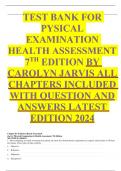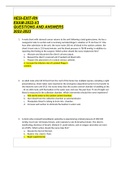Chapter 01: Evidence-Based Assessment
Jarvis: Physical Examination & Health Assessment, 7th Edition
MULTIPLE CHOICE
1. After completing an initial assessment of a patient, the nurse has charted that his respirations are eupneic and his pulse is 58 beats
per minute. These types of data would be:
a. Objective.
b. Reflective.
c. Subjective.
d. Introspective.
,ANS: A
Objective data are what the health professional observes by inspecting, percussing, palpating, and auscultating during the physical
examination. Subjective data is what the person says about him or herself during history taking. The
terms reflective and introspective are not used to describe data.
DIF: Cognitive Level: Understanding (Comprehension) REF: p. 2
MSC: Client Needs: Safe and Effective Care Environment: Management of Care
2. A patient tells the nurse that he is very nervous, is nauseated, and “feels hot.” These types of data would be:
a. Objective.
b. Reflective.
c. Subjective.
d. Introspective.
ANS: C
Subjective data are what the person says about him or herself during history taking. Objective data are what the health professional
observes by inspecting, percussing, palpating, and auscultating during the physical examination. The
terms reflective and introspective are not used to describe data.
DIF: Cognitive Level: Understanding (Comprehension) REF: p. 2
MSC: Client Needs: Safe and Effective Care Environment: Management of Care
3. The patient’s record, laboratory studies, objective data, and subjective data combine to form the:
a. Data base.
b. Admitting data.
c. Financial statement.
d. Discharge summary.
ANS: A
Together with the patient’s record and laboratory studies, the objective and subjective data form the data base. The other items are not
part of the patient’s record, laboratory studies, or data.
DIF: Cognitive Level: Remembering (Knowledge) REF: p. 2
MSC: Client Needs: Safe and Effective Care Environment: Management of Care
4. When listening to a patient’s breath sounds, the nurse is unsure of a sound that is heard. The nurse’s next action should be to:
a. Immediately notify the patient’s physician.
b. Document the sound exactly as it was heard.
c. Validate the data by asking a coworker to listen to the breath sounds.
d. Assess again in 20 minutes to note whether the sound is still present.
ANS: C
,When unsure of a sound heard while listening to a patient’s breath sounds, the nurse validates the data to ensure accuracy. If the nurse
has less experience in an area, then he or she asks an expert to listen.
DIF: Cognitive Level: Analyzing (Analysis) REF: p. 2
MSC: Client Needs: Safe and Effective Care Environment: Management of Care
, 5. The nurse is conducting a class for new graduate nurses. During the teaching session, the nurse should keep in mind that novice
nurses, without a background of skills and experience from which to draw, are more likely to make their decisions using:
a. Intuition.
b. A set of rules.
c. Articles in journals.
d. Advice from supervisors.
ANS: B
Novice nurses operate from a set of defined, structured rules. The expert practitioner uses intuitive links.
DIF: Cognitive Level: Understanding (Comprehension) REF: p. 3
MSC: Client Needs: General
6. Expert nurses learn to attend to a pattern of assessment data and act without consciously labeling it. These responses are referred to
as:
a. Intuition.
b. The nursing process.
c. Clinical knowledge.
d. Diagnostic reasoning.
ANS: A
Intuition is characterized by pattern recognition—expert nurses learn to attend to a pattern of assessment data and act without
consciously labeling it. The other options are not correct.
DIF: Cognitive Level: Understanding (Comprehension) REF: p. 4
MSC: Client Needs: General
7. The nurse is reviewing information about evidence-based practice (EBP). Which statement best reflects EBP?
a. EBP relies on tradition for support of best practices.
b. EBP is simply the use of best practice techniques for the treatment of patients.
c. EBP emphasizes the use of best evidence with the clinician’s experience.
d. The patient’s own preferences are not important with EBP.
ANS: C
EBP is a systematic approach to practice that emphasizes the use of best evidence in combination with the clinician’s experience, as
well as patient preferences and values, when making decisions about care and treatment. EBP is more than simply using the best
practice techniques to treat patients, and questioning tradition is important when no compelling and supportive research evidence
exists.
DIF: Cognitive Level: Applying (Application) REF: p. 5
MSC: Client Needs: Safe and Effective Care Environment: Management of Care
8. The nurse is conducting a class on priority setting for a group of new graduate nurses. Which is an example of a first-level priority
problem?
a. Patient with postoperative pain
b. Newly diagnosed patient with diabetes who needs diabetic teaching
c. Individual with a small laceration on the sole of the foot
d. Individual with shortness of breath and respiratory distress
ANS: D
First-level priority problems are those that are emergent, life threatening, and immediate (e.g., establishing an airway, supporting
breathing, maintaining circulation, monitoring abnormal vital signs) (see Table 1-1).
DIF: Cognitive Level: Understanding (Comprehension) REF: p. 4
MSC: Client Needs: Safe and Effective Care Environment: Management of Care
9. When considering priority setting of problems, the nurse keeps in mind that second-level priority problems include which of these
aspects?
a. Low self-esteem





